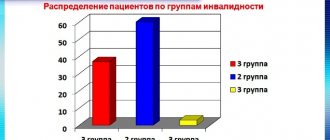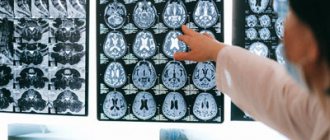The diagnosis of dyscirculatory encephalopathy or chronic cerebral ischemia, as it is also called, sounds scary. But what is it and why is it developing?
For our brain to function normally, it must receive adequate nutrition every day.
Our brain is fed by vessels - arteries, which bring to the brain all the necessary amino acids, vitamins, vitamin-like substances, minerals, biologically active substances, oxygen and much more. And the veins carry all the “processed products” out of the brain. When, for one reason or another, the brain “does not get enough food” or is overfilled with “waste” products, discirculatory encephalopathy , in other words, it is the suffering of the brain from improper blood supply and nutrition.
A number of factors aggravate the course and stimulate the progression of dyscirculatory encephalopathy:
- Acute and/or chronic psycho-emotional stress (stressful work, stressful situation in the family, sleep disturbance, night work, daily work without rest, work in extreme conditions). Stress triggers a destructive cascade leading to cerebral vasospasm and poor blood supply, as a result of which various biochemical processes in nerve cells are disrupted
- Hypokinesia (lack of daily dosed physical activity, lack of daily walks in the fresh air, sedentary work). For normal functioning of the cardiovascular system, it is recommended to engage in any dosed physical activity every day (!) for an hour. But this is not house cleaning work, this is not work in the country house/garden. This could be walking, cycling, swimming, dancing, any cardio training, yoga, or sports games. Such loads stimulate blood flow throughout the body and in the brain.
- Overweight and obesity . Absolutely every obese person sooner or a little later develops arterial hypertension and atherosclerotic changes in the blood vessels of the brain. Atherosclerosis was once thought to be a disease of old age. But it has long been known that atherosclerotic lesions of the aorta develop even in infants. And more and more often we see atherosclerotic changes in cerebral vessels by the age of 30. And, as a rule, this develops against the background of excess weight and poor nutrition. Moreover, I have encountered atherosclerotic plaques in the vessels of the brain in patients under 35 years of age and without obesity, and after a full examination it turned out that the only cause was poor nutrition.
- Alcohol abuse . Frequent consumption of alcohol and in large doses disrupts liver function. Namely, the liver synthesizes endogenous cholesterol (produces its own internal cholesterol). And if the liver works “poorly” and does not remove excess cholesterol from the body, then it enters the bloodstream and remains there on the inner walls of our vessels. The arteries become narrower, the blood supply to the brain is worse.
- Smoking . The smoke of one cigarette contains about 200 different compounds that contribute to inflammation of the inner wall of blood vessels. And cholesterol is layered precisely on inflamed vascular changes. The more we smoke, the more atherosclerotic plaques accumulate on the vessels of the brain and beyond. Atherosclerotic deposits in the heart arteries cause the development of myocardial infarction, and in the vessels of the legs such deposits can cause gangrene and further amputation of the leg/legs.
- Diabetes . Sweet blood is another factor in inflammation of the internal vascular wall, where cholesterol will accumulate. In diabetes mellitus, the formation of atherosclerotic plaques in blood vessels is rapidly rapid. In a relatively healthy person, small increases in cholesterol in the blood may not have any effect on the formation of plaques, but in the presence of diabetes, every drop of cholesterol will be deposited on the blood vessels. If you have diabetes, you should control your cholesterol very strictly and strictly adhere to proper diet therapy. A very dangerous combination of diabetes + smoking + arterial hypertension + obesity.
- Thyroid gland dysfunction . The thyroid gland regulates all types of metabolism in the human body, including cholesterol metabolism. With hyperthyroidism and especially hypothyroidism, cholesterol necessarily accumulates on the blood vessels, causing all those disturbances in brain function that will be discussed later. Therefore, for any diseases of the thyroid gland, hormonal status and lipid metabolism should be monitored.
- In diseases of the cervical spine , especially with neck deformities, severe stoop and/or instability of the cervical vertebrae, compression of the vertebral arteries is possible - this impairs blood flow into the vertebrobasilar basin and in the future contributes to the development and progression of discirculatory encephalopathy.
- Blood diseases with an increased level of hematocrit and/or platelets (erythrocytosis, erythremia, thrombocytosis and other related conditions) contribute to the deterioration of cerebral circulation and brain destruction.
- Heart diseases such as atrial fibrillation and other rhythm disturbances increase the risk of developing cerebral artery thrombosis.
- Vasculitis (inflammatory vascular diseases) also contributes to the destruction of brain tissue.
- Night apnea - stopping breathing during sleep - disrupts cerebral circulation and causes the development of vascular encephalopathy.
- Congenital hypoplasia (narrow diameter) of the cerebral arteries (vertebral arteries and others) can also cause the early and rapid development of dyscirculatory encephalopathy.
Classification
Since discirculatory encephalopathy is not a primary independent disease, but is a consequence of other pathologies that affect blood vessels, the disease is usually differentiated into types depending on the etiological causes. There are varieties:
- atherosclerotic;
- hypertensive;
- mixed;
- venous;
- a form that arose against the background of other diseases: neurocircular dystonia, rheumatism, diseases of the circulatory system.
The disease is also divided into three stages with a gradual increase in clinical symptoms.
How does dyscirculatory encephalopathy manifest?
Its manifestations/neurological symptoms are very varied. And they are combined in an arbitrary way and always in different ways. I will only describe the sensations (complaints), there is no need to describe the symptoms of the neurological status. Your task is to catch the first symptoms by your inner sensations.
It all starts with a decrease in the level of attention and increased irritability. Then comes a feeling of discomfort in the head, anxious thoughts, and headaches. Dizziness and staggering when walking are possible. Performance and the ability to remember new information decrease, increased mental and physical fatigue appears, first at the end of the working day, then constant. Possible depressive disorders, lack of desire to do anything, lack of inspiration to live and work.
Without treatment, discirculatory encephalopathy develops into serious coordination disorders with falls and severe walking impairments, and varying degrees of severity of thinking and memory disturbances occur, up to the development of dementia (severe impairments in memory and ability to care for oneself). Possible hand tremors.
According to statistics, the initial manifestations of cerebrovascular accidents occur more often in men and appear at the age of 20-50 years. And at the age of 60-90 years, vascular encephalopathy affects 95% of people!!!
But we can protect ourselves! If you do not get rid of vascular encephalopathy completely, then at least delay its onset and stop its uncontrolled progression, leading to a significant impairment in the quality of life and decreased performance.
Prognosis for the second stage of the disease
Many people are interested in the question of how long you can live with dyscirculatory encephalopathy of the 2nd degree. There is no clear answer, and there is no statistical data on this matter. In our country, as well as abroad, there is no information about the epidemiological prevalence of this disease.
Patients with degree 2 encelopathy can live a long time - up to 20 years
, and maintaining mental activity until the end. It all depends on the patient’s lifestyle, the characteristics of the course of the disease and the effectiveness of treatment, the goal of which is to prevent the disease from developing to the third stage. Conditions such as degenerative changes in the brain, high blood sugar levels, and frequently recurring hypertensive crises worsen the prognosis.
Advertising:
Disability groups for dyscirculatory encephalopathy:
| Group | Description |
| First group | With DE stage 3 with completely absent ability to self-care. With severe disorders of the musculoskeletal system, blood circulation and severe dementia. |
| Second group | At stages 2-3 DE with significant memory loss and neurological/mental disorders. |
| Third group | At stage 2 DE with moderate neurological and mental disorders. The patient is capable of self-care. |
At the last stage of the disease, brain damage is irreversible, the person loses all connection with the world around him. The diagnosis, unfortunately, is disappointing - how long such a patient can live depends on the care of the medical staff.
Approximate examination plan for diagnosing dyscirculatory encephalopathy:
- Complete blood count (determines the number of red blood cells, hemoglobin, platelets and other blood parameters that affect blood supply to the brain)
- Liver and kidney tests (allows you to evaluate the functioning of the liver and kidneys)
- Coagulogram (necessary to assess the risk of thrombosis and blood density)
- Lipidogram (will show cholesterol level, the ratio of “bad and good” cholesterol
- Blood glucose/glycated hemoglobin (assessment of diabetes mellitus)
- ECG (to determine heart function, detect arrhythmias)
- MRI of the head (will show the presence of dyscirculatory encephalopathy itself)
- MRI of the cervical spine (to evaluate cervical deformity and possible causes of compression of the vertebral arteries)
- Doppler ultrasound of the head and neck vessels with functional tests (will allow you to assess the presence of atherosclerotic plaques, arterial spasm and venous disorders, compression of the vertebral arteries)
- Consultation with a cardiologist (necessary for high blood pressure, heart rhythm disturbances and other diseases of the cardiovascular system)
- Consultation with an ophthalmologist with examination of the fundus (retinal vessels are a reflection of the vessels in the brain; by examining the retinal vessels, the condition of the small vessels of the brain can be assessed)
- Consultation with an endocrinologist (necessary for the treatment of diabetes mellitus, hypothyroidism, hyperthyroidism and other endocrine disorders)
- Consultation with a hematologist (for blood diseases)
- Consultation with a nutritionist (to correct nutrition and get rid of obesity)
- Psychotherapy (necessary in the presence of stress factors, anxiety and depressive disorders).
- Kinesiology and physical therapy with an instructor (if necessary, restore posture)
Diagnosis of encephalopathy in old age
The following studies are needed:
- EEG, which helps to accurately determine the foci of pathological activity of the central nervous system;
- computer and magnetic resonance imaging of the brain;
- angiography of cerebral vessels;
- blood tests (determination of glucose concentration, lipid profile, etc.);
- ECG and Echo-CG.
To assess the severity of cognitive disorders (with the exception of objective examination data), various neuropsychological tests are used (for example, finding certain numbers or letters, constructing a numerical or letter sequence, sorting objects according to certain characteristics).
Symptoms
The characteristic clinical symptoms of dyscirculatory encephalopathy worsen as the disorder worsens. The main signs of pathology are the following manifestations.
- Cognitive problems (memory deterioration, decreased concentration, illogicality and inconsistency of thinking). With stage 3 disease, signs of senile dementia are observed - vascular dementia.
- Disorders of the affective sphere, manifested by abrupt changes in psycho-emotional status. Mood changes are especially pronounced during adolescence, pregnancy, and after childbirth.
- Pyramid disorders - motor dysfunctions: spasticity, paresis or paralysis, problems with coordination of movement, walking impairment, the occurrence of a pathological reflex response. Such problems arise in most cases with grade 2 disculatory encephalopathy.
- Autonomic failures and defects of the vestibular apparatus: surges in blood pressure, dizziness, nausea. They appear already in stage 1 disease.
Among other signs:
- difficulty chewing and swallowing food;
- change in timbre and speed of speech;
- irrational unnatural laughter and crying;
- decreased ability to work;
- facial asymmetry;
- cephalgia.
At the final stage, characteristic phenomena are urinary incontinence and spontaneous defecation.









